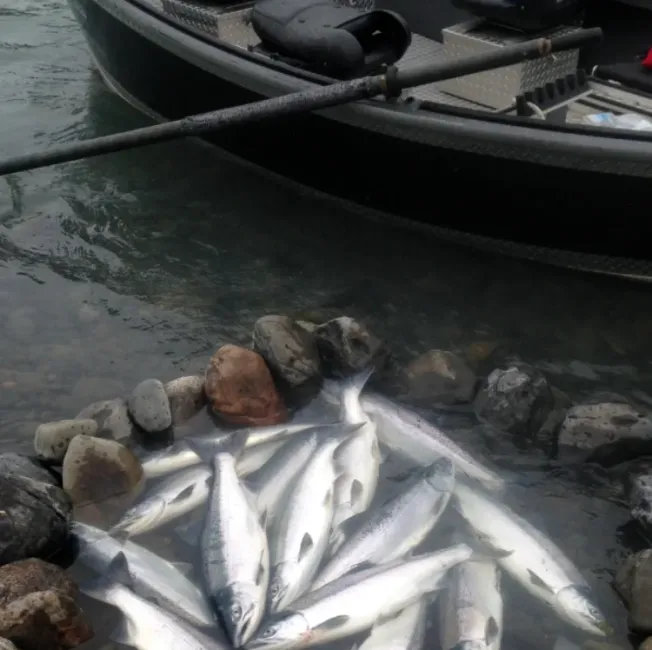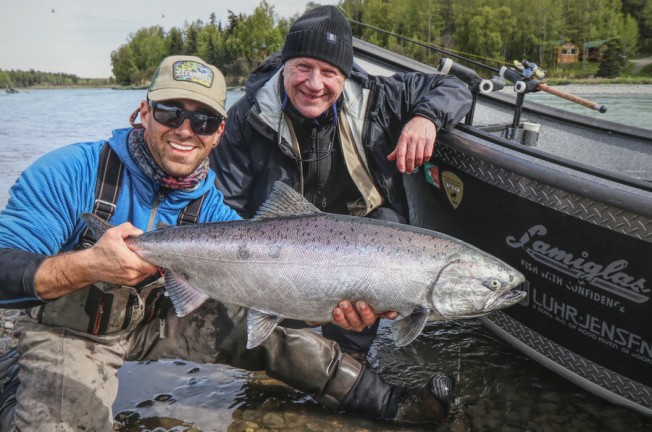
Kasilof River Fishing Guides
Our fully guided fishing trips to the Kasilof River are conducted by drift boat and offer our guests prime opportunities to catch king salmon, sockeye salmon, silver salmon as well as steelhead. Our professional guides will make sure you have the fishing trip of a lifetime. We offer daily fishing charters with our amazing Kasilof River fishing guides beginning in mid-May and extending into October. We begin the season with king salmon and then pursue both sockeye and silver salmon before ending the Kasilof fishing season with steelhead trout.
Where is the Kasilof River?
The Kasilof River is located 10 miles south of Soldotna and the famous Kenai River. It has long been known as the Kenai’s little sister, but it has its own unique history and reputation and offers many excellent fishing opportunities throughout the summer.
The Kasilof River is a large glacial river that drains Tustumena Lake—the largest freshwater body on the Kenai Peninsula and the eighth largest lake in Alaska. Both the river and the lake lie entirely within the Kenai National Wildlife Refuge.
The Kasilof River begins at the outlet of Tustumena Lake and flows for 20 miles before emptying into Cook Inlet.
Kasilof River Fishing and Run Timing

The Kasilof River hosts four species of Pacific salmon: king, sockeye, silver, and pink. The season begins in mid-May with a hatchery return of king salmon to Crooked Creek, a small tributary of the Kasilof located just above tidewater.
This early run consists of both hatchery-raised and naturally produced kings, and it typically peaks from late May through the first two weeks of June. Next to arrive are the sockeye salmon, which begin showing up in late May and continue migrating through July and into August.
The peak of the sockeye run usually occurs during the first couple of weeks in July. Silver salmon start arriving in earnest by early August, with the peak fishing window running from the last week of August into the first week or ten days of September.
Pink salmon are present in August and September, with the highest numbers returning during even-numbered years. The final fish to arrive is the steelhead. They begin returning in late August and continue to run through the fall months of October and into December. These fall-run steelhead overwinter in the river and lake, completing their spawning cycle in the spring.
Our Kasilof River fishing guides know when and where to find Salmon so that your trip is the best it can be! In addition to salmon and steelhead, the Kasilof River also supports populations of both resident and sea-run Dolly Varden char, as well as a resident population of rainbow trout.
Where Do We Fish The Kasilof River?
Where we fish on the Kasilof River depends largely on the species and the time of year.
For king salmon, we fish only one section of the river, as the Kasilof is closed to king fishing above the Sterling Highway bridge. As a result, our king salmon trips focus exclusively on the stretch from the Sterling Highway down to just above tidewater.
Sockeye salmon fishing takes place both above and below the bridge. The upper float is longer, offering more scenic views and access to a greater number of fishing spots. However, the lower stretch can be extremely productive, as tide-fresh sockeye often arrive in tight, concentrated groups.
Silver salmon can also be targeted above and below the bridge, but we prefer the water below. Silvers within tidal reach are especially aggressive and provide exciting action. For steelhead, the best fishing is between Tustumena Lake and the Sterling Highway. These elusive fish move quickly, and covering water is key to finding them.
Our Kasilof River fishing guides make that your are are right where you need to be for your Alaska fishing adventure!
How we fish the Kasilof River
Our Kasilof River fishing guides are experienced and passionate anglers who have spent countless hours on the river. The Kasilof River is a drift boat only fishery, which means motor use is prohibited while fishing. This makes for a very peaceful and unique angling experience. Fishing for kings and silver salmon is largely done from the drift boat with diving plugs or bouncing lures/baits on the bottom.
With sockeye salmon, we use the boat to reach strategic gravel bars and then get out of the boat and fish from shore. We do occasionally catch sockeye from the boat while targeting king salmon. For steelhead, we fish with fly rods or spinning rods with floats and drift fish, or get out and fish from shore.
FAQ’s About Kasilof River Fishing
What is the difference between the Kasilof River and the Kenai River?
Can you keep King Salmon in the Kasilof River?
Can you fish the Kasilof River without a guide?
What is the best month for salmon fishing on the Kasilof River?
Online Booking Options
More Information on Kasilof River Fishing For Kings
In a year that saw record sockeye returns to the Kenai River, the Kasilof River delivered an equally impressive showing. By August 9, a total of 1,197,471 sockeye had passed the sonar at river mile 8, surpassing the previous record of 971,604 set in 2022. Peak run timing occurred between June 30 and July 26, …
The triannual Board of Fisheries meeting for upper Cook Inlet took place in early February in Anchorage and the seven member board, many selected by newly elected governor Mike Dunleavy, voted in favor of several proposals that shifted fish away from commercial fisheries and into the rivers. As the economic value of the fish has …
There is certainly no doubt the Kenai is the world’s most famous salmon river, home to the largest kings on earth and the place of piscatorial dreams. Yet just 20 minutes down the Sterling highway is the Kasilof, a river slightly smaller than the Kenai, but equally rich in historic angling lore and yes, huge …
The 2018 season is well underway and just like every season it has exhibited its own unique personality. Perhaps the most noteworthy characteristic to the season has been the lack of warm weather, especially in mid to late May with temps still dipping into the thirties overnight and struggling to break into the sixties during the …
Early Run Kasilof Kings! Low water and fresh fish makes for some great action. If you are looking for that first fresh salmon of the season, look no further than the Kasilof in late May and early June. After a long winter in Alaska, there is just something special about the first salmon returning to …
Kasilof Sockeye: Drift below Tustumena Lake offers solitude and good numbers of sockeye salmon. Changes in our king salmon fisheries have led us to further diversify and look for additional and exciting new fishing trips. One of these is the float from Tustumena Lake on the Kasilof River down to the Sterling Highway Bridge. Sockeye salmon migration …




















